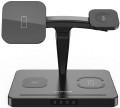Charging areas
Number of wireless zones in the charging design.
The basic option is
1 zone, allowing you to charge one device at a time. To charge several gadgets overnight, models are available for
2 zones,
3 zones and even
≥4 zones. At the same time, at least one zone is made large - it is intended for a smartphone. Other zones can be made in the same caliber as the main one or have smaller sizes, and in some cases they are suspended structures for wrist gadgets (see “Watch charging zone”). Auxiliary zones are usually used to charge another smartphone, a case with headphones, smart watches and other portable devices.
Charge current
The maximum current that the device is capable of delivering to the charging output. This is one of the key parameters for any charger, it directly determines its power and, accordingly, its efficiency with certain batteries. These points are described in detail in the “Power” paragraph below, but here we note that if several values are indicated in this paragraph, it means that the design provides for several connectors with different current specs (or several groups of connectors, each with its own amount of amperes per port) .
As for specific numbers, when charging from USB (used in most modern chargers), the maximum current up to
1 A is considered very limited,
1.5 A is low,
2 A,
2.1 A and
2.4 A are average values, and in the most powerful chargers, this figure can be
3 A,
3.4 A and even
5 A.Power (with 1 device)
The maximum power that the charger is capable of delivering to one rechargeable gadget (for models with 1 connector or with 1 wireless platform — the actual charging power). We emphasize that for wireless devices, it is the power in the wireless format that is indicated here (even if the design has a USB port with a higher power). Wired chargers usually list the USB power with the highest charging current or with support of the most powerful fast charging technology.
The smallest value of this metric nowadays is actually
5 W. Other popular options include
10W,
12W,
15W, and the most powerful models have
18W or more
to charge laptops(up to
100W).
Higher output power allows you to speed up the charging process; and in the case of wireless devices, a value of more than 10 watts already allows us to talk about the presence of fast charging. At the same time, a number of nuances are associated with this parameter. Firstly, not only the charger, but also the gadget being charged should support the appropriate power — otherwise the speed of the process will be limited by the specs of the gadget. Secondly, in order to use the full capabilities of the charger, it may be necessary to support not only the appropriate charging power, but also a
...certain fast charging technology (see "Fast charging"). Thirdly, in a charger with several charging connectors, the maximum power per device can only be achieved if the other ports are not used.Headphone charging power
The power that the device supplies to the headphone charging area. Note that the corresponding zone can be combined with a zone for a phone or watch. And the power is indicated taking into account the technical operation of charging.
Cable included
The presence
of a cable in the delivery kit of the charger, or any other specific type of included cable.
The presence of a cable is indicated mainly for wireless devices (see “Type”) — in such cases, we are talking about the power cable of the charger itself. For wired models, the type of connectors on the stock wire (s) for charging gadgets is usually specified. At the same time, the USB port is used by default to connect to the charger itself, so this plug may not be mentioned in the description of the wire. On the other hand, there may be such connectors:
—
USB-C. A miniature version of the USB connector, gradually replacing microUSB in modern portable devices. It has a convenient reversible plug design, and can also provide some advanced power options not available with microUSB. Also note that USB-C can be used in a cable not only to connect to a gadget, but also to connect to the charger itself (along with traditional USB); so on the market you can find corresponding cables like "USB-C — microUSB", "USB-C — Lightning", etc.
—
microUSB. Universal connector, extremely popular in portable gadgets of various types; only relatively recently has it begun to give way to the more advanced USB-C (which differs from it in its one-sided design and lower power supply).
—
Lightning. Universal connector, used e
...xclusively in portable Apple devices. Like USB-C, it has a two-way layout, but a slightly different design.Cable length
The length of the cable supplied with or included with the charger. For wireless models, the length of the power cable of the charger itself is indicated here, for wired models, the length of the cord for charging gadgets
Anyway, a longer cable gives more freedom of movement, but it creates inconvenience for short distances. Also note that charging is supposed to be used in the immediate vicinity of sockets, so wires longer than 2 m are practically not found among such devices. A length of
more than 1.5 m is considered significant, from 1 to 1.5 m — medium, from 0.5 to 1 m — small, and in some models there are wires shorter than 0.5 m.

